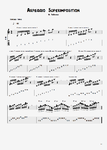degenaro
Active member
Here we go...if we're assuming G major as the parent key the harmonized major scale gives you the following keys...
G major 7
A minor 7
B minor 7
C major 7
D 7
E minor 7
F#m7b5
If you look at the tab there are two master positions...one has the root on the low e, the other on the a string. Of course there are many more but those two are more than enough to get a lot of mileage out of.
You should be able to come up with the ones I haven't tabbed by moving the ones I tabbed to the other positions...
In other words to get a G major 7 arpeggio in master position 2 move the C major position 2 up 7 frets, want the B minor 7 position 1, move the Aminor 7 up 2 frets, B m7 position 2 move the Em7 up 7 frets, etc...
So now to application...look at the sequenced line in the tab...that is the D7 master position 1 arpeggio, now if you play that over say an Am chord the resulting notes d,f#,a,c, will be 4(11), 6(13), root, b3 as they relate to the Am7....so Am 13 is the sound you create.
Over C major that line becomes the 2(9), #11, 13, root...so C major 13#11 sound.
Over G major 5, 7, 9, 11 so G major 11
Over Bm b3, 5, b7, b9 so Bm7b9
etc...
The other way around...the last line is a burner lick that super imposes a bunch of altered dominant sounds over D7.
... the obvious inside thing would be that same lick we used, then D7 master position 1...starting on then 10th fret e-string...
Now play the same lick 2 frets down...C7 arpeggio against D7 that gives you c, e, g, bb, or related to the D7 the b7, 9, 11, #5
Up 4 frets to the E7 arpeggio (2 frets up from D) superimposing the 9, #11, 13, root...D13#11
Up another half step (3 up from D) to F7 and you get the #9, 5, b7, and b9 for a D7b9#9 sound
Up another whole step (5 up from D) and you get the 11, 13, root, #9 for a D13#9
Up another half step (6 frets from D) and it's the b5, b7, b9, #9 for a D7b9#9b5
Up another 2 (8 from D) and it's #5, root, #9, b5 for a D7#9b5#5
G major 7
A minor 7
B minor 7
C major 7
D 7
E minor 7
F#m7b5
If you look at the tab there are two master positions...one has the root on the low e, the other on the a string. Of course there are many more but those two are more than enough to get a lot of mileage out of.
You should be able to come up with the ones I haven't tabbed by moving the ones I tabbed to the other positions...
In other words to get a G major 7 arpeggio in master position 2 move the C major position 2 up 7 frets, want the B minor 7 position 1, move the Aminor 7 up 2 frets, B m7 position 2 move the Em7 up 7 frets, etc...
So now to application...look at the sequenced line in the tab...that is the D7 master position 1 arpeggio, now if you play that over say an Am chord the resulting notes d,f#,a,c, will be 4(11), 6(13), root, b3 as they relate to the Am7....so Am 13 is the sound you create.
Over C major that line becomes the 2(9), #11, 13, root...so C major 13#11 sound.
Over G major 5, 7, 9, 11 so G major 11
Over Bm b3, 5, b7, b9 so Bm7b9
etc...
The other way around...the last line is a burner lick that super imposes a bunch of altered dominant sounds over D7.
... the obvious inside thing would be that same lick we used, then D7 master position 1...starting on then 10th fret e-string...
Now play the same lick 2 frets down...C7 arpeggio against D7 that gives you c, e, g, bb, or related to the D7 the b7, 9, 11, #5
Up 4 frets to the E7 arpeggio (2 frets up from D) superimposing the 9, #11, 13, root...D13#11
Up another half step (3 up from D) to F7 and you get the #9, 5, b7, and b9 for a D7b9#9 sound
Up another whole step (5 up from D) and you get the 11, 13, root, #9 for a D13#9
Up another half step (6 frets from D) and it's the b5, b7, b9, #9 for a D7b9#9b5
Up another 2 (8 from D) and it's #5, root, #9, b5 for a D7#9b5#5

